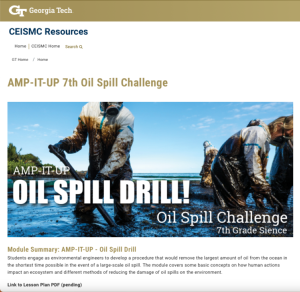Oil Spill Challenge: Oil Spill Drill

This resource, published by Georgia Tech Research Institute, features a science activity designed for seventh graders. In this activity, students act as environmental engineers to develop a procedure that removes the largest amount of oil possible from the ocean in the shortest amount of time in the event of an oil spill. Students use a scale model of an actual oil spill to test their procedures and generate histograms. The module covers "basic concepts on how human actions impact an ecosystem and different methods of reducing the damage of oil spills on the environment." It meets the following learning standard:
-
Obtain, evaluate, and communicate information to examine the interdependence of organisms with one another and their environments.
The activity is divided into four sections that last five class periods. The prep guide includes materials needed, planning, key questions and concepts, and grading opportunities for each section of the activity. The resource includes the following:
- A 26-page curriculum booklet with an annotated teacher's version
- A 10-page teacher's prep guide
- Materials list
- Supply checklist
- A 6-page student worksheet packet
- Histogram worksheet
- Two videos providing context around oil spills and oil spill cleanups
Comments